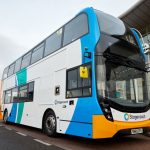First Eastern Counties has invested £5.3m in 19 custom-designed double-deckers for its flagship Excel service between Norwich and Peterborough. They will enter service on 17 February, the culmination of a two-year project that the operator says has delivered “accidental innovation.”
The combination of Alexander Dennis (ADL) Enviro400 City bodywork on diesel-fuelled Scania N 250 UD chassis makes its debut in the Excel buses. They have cost almost £280,000 each and will run from King’s Lynn depot.
If anything, the chassis and bodywork is the simple bit. Perhaps more interesting aspects are the reasons behind the buses’ purchase and the thought that has gone into specifying them.
Collaboration for First Eastern Counties Excel
First Eastern Counties MD Steve Wickers gives credit to suppliers besides ADL and Scania for their contribution to the overall Excel product.
Lazzerini has adapted its seats to suit First. Each of the buses has 65 high-backed Transito models fitted. They are trimmed in real leather. Integrated consoles that include a phone holder, USB and wireless charging and a stop request button are at most positions.
Others are around two tables on the upper deck, while the rear row in both saloons is four abreast with armrests between each position. Meanwhile, McKenna Brothers has contributed the enhanced next stop audio-visual announcement system and destination displays using Mobitec equipment.

Ray Stenning’s Best Impressions has created the red-based Excel brand.
Mr Stenning has not just designed a livery; the buses have a complementary interior scheme that promotes the network.
And for First Eastern Counties, Excel is now indeed a network. Until Saturday 15 February it will maintain its current single routing.
Beyond that it will be split into four services, A-D. Each fulfils a slightly different purpose, recognising that Excel primarily delivers many shorter-distance journeys and not end-to-end trips.
Perhaps most notably, First will significantly step up its offering between Norwich and Dereham. Service D will run non-stop between the two.
The D routing has been introduced to cater for commuter demand, says Marketing Manager David Jordan. The Excel network expansion will see its PVR rise from the current 14 to 17. It will also deliver faster journeys to Norwich from points farther west.
Excel: Jewel in First Eastern Counties’ crown
The buses’ arrival will see the existing Excel stock, a batch of 63-plate Enviro400 integrals, moved elsewhere within First Eastern Counties. They will eventually be repainted and refurbished, says Mr Jordan.
That plan demonstrates First’s current approach to fleet investment. It is now more targeted than before, explains UK Bus MD Giles Fearnley.
Clean Air Zones and Scotland’s Low Emission Zones account for some new vehicles. Elsewhere, as demonstrated by Excel, deliveries will be allocated to ‘crown jewel’ services. That will permit older buses to be cascaded to less demanding or less prominent work.
First’s previous policy with what is now its Excel brand has been to replace vehicles at between five and six years of age. That is because of mileage. A one-way trip from Norwich to Peterborough is 85 miles.
With the new Scania ADLs the interval may be stretched, says Mr Jordan. First Eastern Counties believes that the Scania/ZF driveline is particularly durable and well-suited to high-mileage work.

The operator made selecting the most appropriate vehicle a key part of its evaluation process.
It even examined whether coaches would be suitable, but they were disqualified thanks to stop dwell time concerns. Difficulties carrying wheelchair users and buggies also contributed to that decision.
One of the reasons for pushing ADL for the Enviro400 City on Scania diesel chassis relates to the body’s “wow factor”, adds Mr Jordan.
The buses will spend a lot of their time on the A47. The offside is what will be seen by a target market: Car users, hence the glazed staircase. Passenger numbers on Excel have shown consistent growth. That is something First Eastern Counties expects to continue with the new buses and enhanced timetable.
Notably, that growth has come despite worsening congestion and lengthened journey times. The outgoing Enviro400s are to a high specification. First believes that ridership can be grown despite increasing congestion if the product offered is right.
Safety considerations rank highly
Various safety items have been fitted to the new fleet. Most noticeable is the use of rear-view cameras instead of mirrors. They are on all 19 buses.
Mr Fearnley says that where First has trialled such cameras in Glasgow, they have been favourably received. The drivers’ union there had no objection, and what was expected to be the biggest difficulty – staff transferring between camera- and non-camera-equipped buses mid-shift – did not cause problems.
At current prices it is not viable to specify rear-view cameras on all new buses, he continues. But in time, when unit cost decreases, Mr Fearnley expects cameras to become a standard fitment on all deliveries.
Further technology comes in the form of a ‘seeing eye’ system in the cab. A small device monitors the driver’s face and can identify when signs of fatigue are shown. If that happens, the seat vibrates. A notification is also sent to the depot allowing management to check the driver is OK.
First has also worked with Jimmy Beam Downlights (JBD) to fit the Vehicle Avoidance Lateral Light (VALL) system. That involves down-facing lights fitted externally around two feet from the ground, identifying what JBD calls “an area of high risk”.
Each VALL unit is also an integrated side marker light. JBD says it helps the driver to position the bus safely in times of poor light, reducing damage and improving safety around vulnerable road users and pedestrians.
While the VALL system is in use on a trial basis with Metroline in London, Mr Wickers says that on its Excel buses, First Eastern Countnies is the first operator to place an order for the product. As with the rear-view cameras and the ‘seeing eye’, it was specified locally rather than as group policy.
Will Transforming Cities Fund lead to further investment?

The major investment in Excel will be followed up with an even bigger spend on the Norwich urban fleet, should the city be successful in its bid for money from the government’s Transforming Cities Fund (TCF).
TCF results are due to be announced next month. If Norwich is among the winners, First has committed £18m of its own money. That will see at least 50 new buses delivered, and the retained fleet refurbished to the same standard.
All of that would need to be complete by March 2023. As part of the overall work, around two-thirds of the Norwich fleet would satisfy Euro VI emission levels. The remainder would be Euro V, says Commercial Manager Paul Martin.
The same degree of customisation would not be seen on buses for urban routes in Norwich as that on the new Excel fleet.
With the latter buses, First has demonstrated that it can hold its own in terms of innovation. The Excel Scania ADLs have aspects that suit passengers – including high-specification seats, tables and a couple of single positions on the upper deck – and drivers.
Mr Jordan reports that staff at King’s Lynn are “itching” to get behind the wheel of the buses. Such investment helps to keep them engaged in the business’s ongoing prosperity.
If targeted commercial investment can be coupled to TCF success in areas where First is involved in bidding, the potential to upgrade entire networks is significant. Not all locations have services that justify such expenditure. But in the new Excel fleet, First has demonstrated its continuing willingness to spend heavily when appropriate.
routeone comment
The big groups, and others, have been involved for some years in what has become an almost competitive process to push the boundaries in terms of interior specifications for buses used on high-profile services.
Perhaps the most notable aspect of Excel, and other such flagship routes, is how they demonstrate that patronage can be grown even as congestion worsens.
Politicians have little idea of how to address the latter problem. With concepts such as Excel, and the added value that they bring to passengers and the rise in usage they deliver, the industry is adding weight to its case for increased external investment.
Further major outlay from operators will be tied in with Transforming Cities Fund money. In the meantime, it’s important that the industry continues to demonstrate its willingness to invest, innovate and upgrade if it is to quell further calls for reregulation.

























